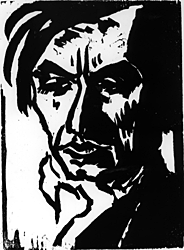

There are undercurrents in the human psyche: erotic, irrational and violent ones, which lurk beneath culture as a whole. These can manifest themselves in surprising and disturbing ways. "German Expressionism" is the name given to a various number of related artistic movements within Germany from the beginning of this century to their forced end with the rise of National Socialism.
These artists, by forming utopian communities, attempted to make visible the inner realm of the psyche through their respective artistic mediums. Their work adds tremendous insight into the course of German history during this period. The works on display in the Allen Art Museum's new show "Utopia and Alienation: German Art and Expressionism" are a map of desires, failures and horrors. Each piece is a deeply psychological probing into the nature of a people and the society they create.
The curators of the exhibit, Assistant Curator of Western Art Stephan Jost and Marjorie E. Weisman, Curator of Western Art before 1850, have chosen to exhibit the works by theme: the landscape, the nude, portraiture and self image and modern life. This is a subtle and intelligent choice, bringing out different facets of the movement.
The most striking of these themed sections is that of the self-portrait. Included here is Ernst Ludwig Kirchner's haunting oil Self-Portrait as Soldier. The figure of the uniformed soldier dominates the left portion of the canvas, while behind and to the right of this main compositional feature is a female nude. The painting displays strong symbolism: the soldier's right hand has been cut off, and Kirchner paints the soldier with a cigarette hanging from his mouth. There is a less definable sense to this work, one perhaps closer to primacy. The portrait is somehow inhuman - alien and distorted.
The other portraits, notably the work of Emil Nolde, have a similar ability for self-commentary, showing up the dark places that reside within the artists. More varied in tone than the portraits, the nudes in the exhibition present the aesthetic uniqueness and individualism of the artists. Implication and suggestion are used to create a spontaneous, emotional sense of form.

Shape is often distorted or fragmented, creating pieces that are tumultuous and suggestive. The works by Kathe Kollwitz in particular are extremely intense, compressing loss, power, sex and death into such a tightly wraught canvas that they become inseparable. This combination is a potent one, and it speaks deeply of the peculiarly German disposition toward cataclysm and violent change that this time period is known for.
The "modern life" and "landscape" portions of the exhibit are less immediate in their impact than the above sections, but they are still intriguing.
The portrayals of urban life are filled with an ironic social commentary that is heretofore unseen in the show. The artists use the caricature technique, tempered with a current of pessimism, to display their views of city existence. In contrast, the landscapes are far brighter and more hopeful; a reflection of the movement's utopian desires.
This utopianism is the romantic desire to return to the past. The landscapes reflect not the horrors of industrialization and self-alienation, but rather the beauty found in nature.
The pieces on exhibition in "Utopia and Alienation" are a glimpse of the subliminal underpinnings of a culture in dramatic and violent change. Not a safe place to be, perhaps, but a necessary and revealing one.
In a first for the Allen, several of the works in the exhibit are on loan from the Cleveland Museum of Art and the University of Iowa Museum of Art-hopefully collaborations of this sort will continue. The exhibit runs September 17 to December 19. Dr. Reinhold Heller will speak on "The Utopian Project of German Expressionism" on Sept. 24 at 4 p.m. with a reception to follow.
"Der Sanger" (The Singer): Emile Nolde's woodcut. (photo courtesy of Allen Memorial Art Museum)
Copyright © 1999, The Oberlin Review.
Volume 128, Number 3, September 17, 1999
Contact us with your comments and suggestions.